August 3, 2007
Air Date: August 3, 2007
FULL SHOW
SEGMENTS
U.S. Coal Losing its Glow?
/ Jeff YoungView the page for this story
U.S. "COAL RUSH" SLOWS DOWN: The push to build as many as 150 new coal-fired power plants could be running out of steam. Dozens of coal projects have been scrapped as investors fret over the cost of controlling greenhouse gas emissions. Living on Earth's Jeff Young reports from Washington. (05:30)
Chinese Coal Rush
View the page for this story
The U.S. coal market is slowing down in the face of impending federal regulation of carbon dioxide, but construction of coal-fired power plants in other parts of the world is moving full steam ahead. Chinese banks now fund the construction of as many as two or more new coal plants each week. Host Steve Curwood talks with Orville Schell, director of the Center on U.S. China Relations at the Asia Society, about China's growing energy market. (06:20)
Chalmette’s Troubled Vista
/ Ingrid LobetView the page for this story
Two years after Hurricanes Katrina and Rita, the community of Chalmette Vista, outside New Orleans, is struggling to get back on its feet. The Gulf Coast community sits next door to an oil refinery complex and is not only up against problems with levees, land and housing, but also acrid smells and air pollution. Living on Earth’s Ingrid Lobet reports. (18:00)
Bisphenol A on the Burner
/ Ashley AhearnView the page for this story
The government will soon weigh in on the safety of Bisphenol A, an estrogen-mimicking chemical now found in the bodies of most Americans. Bisphenol A is used in plastic toys, bottles and other containers, and a growing body of research shows people are carrying the chemical at levels know to cause immune, neurological and reproductive problems in lab animals. Living on Earth’s Ashley Ahearn reports. (05:30)
Emerging Science Note/Super Sponge
/ Amy FishView the page for this story
A new aerogel acts like a super sponge and can soak up chemicals. Living on Earth’s Amy Fish reports. (01:30)
A Buffalo in the House
View the page for this story
Roger Brooks and Veryl Goodnight never intended to keep a buffalo as a permanent guest in their suburban Sante Fe home, but that's what happened. Host Steve Curwood talks with the subjects of a new book by R.D. Rosen, called "A Buffalo in the House." (08:45)
This week's EarthEar selection
listen /
download
Thermal burps and gurgles from Yellowstone National Park.
Show Credits and Funders
Show Transcript
HOST: Steve Curwood
GUESTS: Trevor Houser, Orville Schell, Veryl Goodnight and Roger Brooks
REPORTER: Jeff Young, Ingrid Lobet, and Ashley Ahearn
SCIENCE NOTE: Amy Fish
[THEME]
CURWOOD: From Public Radio International – this is Living on Earth.
[THEME]
CURWOOD: I’m Steve Curwood.
Long before Hurricanes Katrina and Rita flooded out Chalmette, Louisiana residents there suffered from pollution from the neighboring oil refinery. Now as they struggle to rebuild, having a healthy neighborhood seems more and more elusive.
FORD: Now I feel like I’m a white man looking at my environment my neighborhood getting destroyed and can’t do a damn thing about it except look out there and cry.
CURWOOD: Also, the law calls for refineries to estimate how much pollution they emit. And new technology is showing that many of those estimates have been off---way off, in some cases.
CUCLIS: The refineries are at least three times higher than what they are reporting, more typically 10 times higher and sometimes 30 times higher or more than what they report.
Petroleum, people and pollution, and more this week on Living on Earth, stick around.
[NPR NEWSCAST]
ANNOUNCER: Support for Living on Earth comes from the National Science Foundation and Stonyfield Farm.
[THEME]
U.S. Coal Losing its Glow?
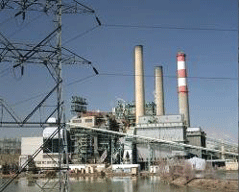
A coal-fired power plant. (Courtesy the Office of Senator Patrick Leahy (D-VT))
CURWOOD: From the Jennifer and Ted Stanley Studios in Somerville, Massachusetts – this is Living on Earth. I’m Steve Curwood. A voracious appetite for electricity has the U.S. racing to build new power plants, many of them fired by coal. Just a few months ago some 150 coal burners were on the drawing boards. But a funny thing happened on the way to the coal rush: people who would pay for those new power plants started saying “no.” Plans for more than a dozen coal power plants have been cancelled so far this year due to concerns about climate change, air quality and cost. As part of our series “Generating Controversy: The Changing Climate of Coal,” Living on Earth’s Jeff Young explains why coal could be losing its glow.
YOUNG: Florida needs more juice—electricity, that is. Fast-growing Florida’s power demand could climb 60 percent in the coming decade. So the electric company Florida Power and Light proposed what would have been one of the largest coal-fired facilities in the country. Would have been, except the state’s Public Service Commission turned it down. And a month later another company dropped plans for a coal plant. Florida’s Republican Governor, Charlie Crist, recently launched an aggressive global warming campaign in the sunshine state. He says coal’s future there is not so bright.
CRIST: Hah, it’s not looking good. We’re obviously moving in a different direction. I think we need to continue to explore solar, wind, nuclear. We’ve got to have power, we know that. But continuing to rely on coal I don’t think is in the best interests of our state or our country.
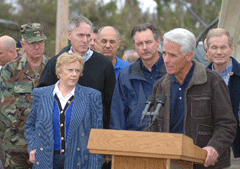
Florida Governor Charlie Crist (Courtesy of the Office of Governor Crist)
YOUNG: Florida’s not alone. Illinois, North Carolina, Oregon, and Texas all scrapped plans for coal power, and proposals elsewhere are floundering. The “Coal Rush” appears to be going cold and it’s largely due to concerns about a warming climate.
NILLES: These coal plants are an enormous source of carbon dioxide.
YOUNG: Sierra Club attorney Bruce Nilles says coal pumps out more greenhouse gases per unit of energy than any other fossil fuel. Several states are limiting greenhouse gases and Congress is slowly moving toward federal regulation of carbon dioxide. Nilles says that means a cost of coal that had been ignored—the impact on climate—will soon be forced onto the ledger sheets.
NILLES: The moment we start doing something about global warming these coal plants become dinosaurs—in essence very expensive white elephants that put an enormous risk who’s ever put up the money to build those coal plants.
YOUNG: The financial community seems to be getting the message. Influential analysts at Citigroup recently downgraded their recommendation of coal company stocks citing the high cost of controlling CO2. The Citigroup report says, quote: “prophesies of a new wave of Coal-fired generation have vaporized." The report also notes that coal is taking a beating in election year politics. Here's Democratic hopeful John Edwards on the campaign trail.
EDWARDS: I think we ought to cap greenhouse emissions in the United States of America and, by the way, until and if we do there should not be another coal fired power plant built in the United States of America. (cheering)

A coal-fired power plant. (Courtesy the Office of Senator Patrick Leahy (D-VT))
YOUNG: All the Democrats and at least one Republican running for president support a cap on carbon emissions. And Congress is already moving that way. A climate bill could emerge from committees in both the House and Senate this fall. Senate environment committee chair Barbara Boxer says talk about the bill is already having an effect.
BOXER: I think it’s a very good sign that people, the business community, is saying there is a cost to this and let’s not rush with dirty technologies.
YOUNG: But the power industry says reports of coal’s demise are exaggerated.
RIEDINGER: We think outlook for coal is extremely strong.
YOUNG: That’s Dan Riedinger, a spokesperson for Edison Electric Institute, the trade group representing most major power producers.
RIEDINGER: You know the feeling a couple years ago was that coal was making this huge unstoppable resurgence. And now some are predicting that the brakes are being applied rather aggressively. Really the truth has always been somewhere in the middle. There will be new coal-fired generation, and, sure, there will continue to be some cancellations of coal plants that were proposed a couple of years ago.
YOUNG: Riedinger says even if half the planned projects fall through, well, half of 150 is still a lot. And one sector that’s bullish on coal is getting help from the government. Rural power cooperatives around the country want to spend tens of billions on new coal power. Co-ops get government-subsidized loans thanks to a federal program dating to the Great Depression. Daniel Lashoff at Natural Resources Defense Council says that program, the Rural Utilities Service, has outlived its original purpose.
LASHOFF: It was created in the 1930s to bring electricity to rural farms and now is being used to subsidize construction of conventional dirty coal plants in parts of the country that are increasingly not rural.
YOUNG: Which brings us back to Florida. One of the last remaining coal power proposals there comes from a rural cooperative. Seminole Electric wants a billion dollar loan to expand its coal burning plant near Tampa. Pending decisions on that and other power plants still on the drawing boards around the country will show if the coal rush still has any steam in it.
For Living on Earth, I’m Jeff Young in Washington.
Related links:
- Sierra Club has mapped many of the proposed coal projects
- Edison Electric Institute on coal as part of the energy mix
- Florida’s Global Warming Campaign
- Article on Citigroup’s Down Grading of Coal Stocks
Chinese Coal Rush

View of Shanghai under a cloud of air pollution. (Photo: sabershadezero)
CURWOOD: While concern about the future costs of carbon emissions is putting the squeeze on the largely private investment in coal in America, things are different in China. There, in the face of local power shortages, regional government banks are funding as many as two or more new coal fired plants every week. These local funding authorities seem to be little concerned about climate change, although the estimated 750,000 deaths linked each year to coal pollution have touched off some protests. Trevor Houser is an energy expert with the China Strategic Advisory group. He says restrictions on household savings are driving this construction boom in coal plants.
HOUSER: Chinese citizens can’t invest money outside of the country, they can only invest money in domestic assets, so their options are fairly limited in what they can invest and the majority of them put their money into the banks.
CURWOOD: Those banks, in turn says Trevor Houser, favor heavy industries - cement, aluminum and steel –industries that are heavy users of electricity.
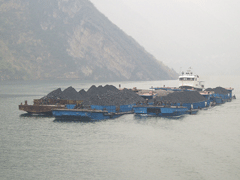
Coal barges make their way up China’s Yangtze River. (Photo: wjpbennett)
HOUSER: That bias is in part due to the lack of a credit system so that state owned banks are a little scared to lend out to 1,000 small private textile companies when they can lend the same amount to three big state owned steal mills that they know they can get the investment back from.
CURWOOD: That was Trevor Houser of the China Strategic Advisory Group. Orville Schell recently returned from China. He’s the Director of the Center on U.S. China Relations at the Asia Society. Mr. Schell says that the Chinese Central government is having a hard time reigning in the construction of coal plants in the provinces.
SCHELL: Unlike our own country, the central government in China and Beijing has become quite enlightened and quite alarmed by what they’ve learned about the effects of coal, of industrialization both in terms of conventional pollutants and climate change. But at the local level down at the provinces, counties and municipalities where economic decisions are made, and where the careers of officials are judged by the economic progress that they catalyze. It is very difficult for these central government policies to be effectively carried out in terms of environmental standards being maintained on new factories so you get this sort of insurgent proliferation of power plants that are financed by local banks for whom the land has been given by local governments and deals in which the officials are in league with each other and getting pay offs to build them. So, the central government has a very hard time patrolling what goes on out in the provinces.

Pollution from Beijing mutes the air around the Great Wall of China. (Photo: vicky tricky)
CURWOOD: Now, I imagine that the average person out on the street in China isn’t all that worried about climate change but is pretty bothered by the air pollution, the environmental quality that coal degrades for him or her. How much are Chinese citizens responding to the challenge of pollution from coal?
SCHELL: Yeah, it’s very interesting. Environmental problems are causing people great anxiety. And in an increasing number of cases leading to demonstrations, protest, and sometimes violent confrontation with authorities. There was a case about five weeks ago in Fujian in Xiamen on the coast where a paraxylene factory was scheduled to built and through the technological advancement of cell phone communications people started text messaging all over the city and tens of thousands of people poured out into the street to protest against it. This is very alarming to the government. And there have been other cases where land is confiscated from peasants for power plants. Rivers have been terminally polluted with industrial effluent. Lead smelteries have been belching toxic smoke out over a rural area where people have actually risen up and fought with guns and weapons and people have been killed. So, the government now sees that this is not a problem that they can simply kind of ignore. It is something that has grave consequences not only for social instability but for the health of the nation and also for the economy because it is estimated, and you see the most wildly diverging estimates but I’ve seen estimates from 3 to 10 percent of GNP as the cost of the environmental degradation caused by this rapid industrialization.

View of Shanghai under a cloud of air pollution.(Photo: sabershadezero)
CURWOOD: So, China is committed to moving its people ahead. And the one resource it really has is coal. It seems like there’s a collision really being set up: China’s desire to move forward and its use of a substance which is already choking itself and could end up helping to choke the entire planet. How do you get out of this box?
SCHELL: Well, I think the only way to get out of it, if you look at this in bilateral terms is for China and the U.S. to both acknowledge that there is a huge problem. It isn’t helpful for the U.S .to say “It’s China’s problem and China’s responsibility” or for China to say the same about the U.S. Why? Because their problem is our problem. Their pollutants are our pollutants. Their addition of greenhouse gasses to the atmosphere detracts from our account and our wellbeing. So, we have no choice it seems to me but to get together to remedy this. Something we’ve not really done at least not in as substantial a way as I believe we should do. And I think we need to bring Japan into this. Why Japan? Because they have capitol, they have technology and they have in fact cleaned up their environment. They have a lot of experience. We need a major new initiative between the U.S. and China that stops blaming each other, that starts allotting a new kind of responsibility for the remedy or we’re never going to get on top of it.
CURWOOD: Orville Schell is Director of the Center for U.S. China relations for the Asian Society in New York. Thank you so much sir.
SCHELL: Pleasure.
CURWOOD: To listen to other parts of our series “Generating Controversy: The Changing Climate of Coal,” go to our website: loe(dot)org
[MUSIC: Peter Gabriel “Digging in the Dirt (instrumental)”’Real World’ (Peter Gabriel Ltd – 1992)]
Related links:
- Peterson Institute Report on China’s Future Energy Market
- Asia Society’s Center on US-China Relations
Coming up: hard to breath, hard to live. A Gulf Coast community downwind from a refinery complex struggles to survive pollution and the wreckage of Katrina. Keep listening to Living on Earth.
Chalmette’s Troubled Vista
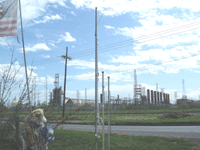
(Photo: Ingrid Lobet)
CURWOOD: It’s Living on Earth. I’m Steve Curwood. As part of our continuing coverage of the rebuilding of New Orleans, we visit the Chalmette Vista neighborhood of St. Bernard Parish. Chalmette Vista is right next to a major oil refinery complex and even before Hurricanes Katrina and Rita flooded out virtually every home, residents were as used to acrid odors and washing the refinery soot off their cars as they were to eating crawfish. Today, about a third of the residents have returned and they find themselves wondering if Chalmette Vista can become a viable community. Living on Earth’s Ingrid Lobet reports.
LOBET: In Chalmette Vista when you look up, you see the pipelines and stacks of the Exxon Mobil refinery. Look down and the neighborhood stretches out like a sick patient, two years after the twin visitations of Katrina and Rita. The floods swept away everything Ray Clement had except his wife’s ashes. While he talks, a small ball of orange fire appears at one the refinery stacks and extinguishes in black smoke. The Gulf breeze carries an acrid smell.
CLEMENTS: Crude oil, that is what you get a lot of, that crude oil smell. Mostly that rotten egg smell and ammonia, smell like ammonia, it takes your breath away.
LOBET: This was one of the most populous refinery communities in the country. But Clement and other says it was never easy to live here. Often you had to close your windows to the smells, even in the heat of summer. And sometimes that wasn’t enough.
CLEMENTS: You couldn’t stay in the house. You’d go take a ride, a walk in the Quarter or something, but there’s no place to go here no more.
LOBET: No place to go because so many businesses are closed now, their patrons scattered in a St. Bernard diaspora. A few remain, and perhaps the community’s best-known resident, Ken Ford. Ford and his wife raised two children here and he repaired airplanes for the National Guard. But the reason for his reputation is that he kept records on refinery emissions for four decades and tried to organize his neighbors to agitate for cleaner air, but that community memory bank is gone.
FORD: My neighbor Frank Dear, he’s gone he ain’t coming back. He knew what was going on. Across the street he knew what was going on, 54 years here. George Blester and Lou Blester they both died. People aren’t coming back. The people I said earlier, that know what’s going on, aren’t coming back.
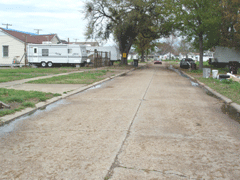
Trailers visible in Chalmette Vista neighborhood where every single house was destroyed. Some of the houses show recent repairs. (Photo: Ingrid Lobet)
LOBET: Ford gestures at the FEMA trailers that still edge out of driveways here. Empty houses once worth 110 thousand dollars, now offer themselves up for 40 thousand as sellers pray for a buyer, a miracle. He shows a visitor past his gutted-out house to where a small frame building lists sideways.
[SOUNDS OF FOOTSTEPS AND DOOR OPENS]
FORD: Don’t break your neck in here. See all this is ruined, everything’s ruined.
LOBET: This back building was Ford’s war room, buzzing with scanners, a ham radio, and full of color-coded binders, thick with minutes from public meetings and air monitor read-outs. Little remains, just the smell of mildew and a water-worn photograph signed by Erin Brockovich.
FORD: I said what I am supposed to do Erin? And she said, “Never give up. Erin, Lot’s of love.” So I kept it.
LOBET: Sometimes, Ford says, he feels like that Indian in the 1960s public service announcement, the one with no words, where the guy gazes at litter along the highway and you see a tear on his cheek.
FORD: Now I feel like I’m a white man looking at my environment, looking at my neighborhood getting destroyed and can’t do a damn thing about it but look out there and cry.
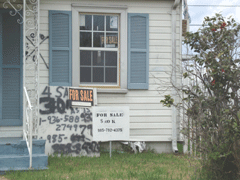
Damaged house up for sale in Chalmette. (Photo: Ingrid Lobet)
LOBET: Chalmette residents were mostly white; old time families often had Italian, Irish and Spanish Canary Island backgrounds. Over the years Ford did attract a few supporters, the Tulane University Environmental Law Clinic. And an organizer from Cajun country, the founder of a group called the Bucket Brigade, Anne Rolfes.
[DOOR OPENS, DOG BARKING]
ROLFES: Hello how you doin’? My name is Anne, I’m here with the Bucket Brigade.
LOBET: Like Ken Ford, Anne Rolfes refused to give up on Chalmette Vista after hurricane Katrina. On this day she’s trying to find out who, among those left here, would be willing to write down when they see or smell something in the air. Louise Serpas steps past her barking dog and says she’d be glad to.
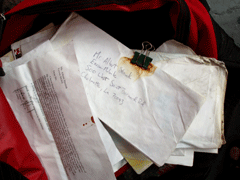
A knapsack full of letters from community members to Exxon Mobile expressing their concerns about air pollution from the company’s nearby refinery. (Photo: Ingrid Lobet)
ROLFES: If you see things like a flare, or smoke
SERPAS: We do, right there look, at night.
ROLFES: See okay, alright so you know what would be really great--
SERPAS: Sometime it’s black but most of the time it’s fire!
ROLFES: Well you know and that’s exactly what we would like you to do, because…
LOBET: Perhaps because the neighborhood is so quiet now, Ms. Serpas isn’t eager to see a visitor leave, even if her dogs are.
SERPAS: If it wouldn’t be for the dogs I’d invite you all inside. Bye baby.
LOBET: It may be too early to say whether the flooding dealt a mortal blow to this community. A few pre-Katrina neighborhood anchors have returned, and lightened people’s hearts: especially Rocky and Carlo’s Restaurant where a plate rich with olives is still called a “wop salad.” But it’s clear that a place that was hardscrabble before, is even harder now and part of the reason is Americans’ demand for gasoline. Ken Ford says a little refinery once built by the Standard Fruit Company to fuel its Central American banana boats has swelled to many times that size.
FORD: Where today we have a refinery close to 200 thousand barrels today. Besides all the chemicals they make it’s not just the refinery, it’s the manufacturing plant. They make benzene.
LOBET: American refineries have been running full bore, even before the 2005 hurricanes that took several offline, including Chalmette. To meet growing demand, refinery owners around the country have expanded capacity at existing plants rather than build new ones, in part because getting a permit for a new refinery is so difficult. Howard Feldman is with the American Petroleum Institute.
FELDMAN: Everybody wants the fuels, and nobody wants the refinery nearby. There are tradeoffs obviously.
LOBET: With plants running at capacity, equipment failures and accidental releases of pollutants are more common. Two years ago a federal judge in New Orleans ruled Chalmette refinery had released illegal amounts of benzene into the air more than 1200 times in the two preceding years.
And documents obtained by this program show Chalmette Refinery frequently asks the state of Louisiana for permission to emit extra pollutants, such as sulfur dioxide, and those requests are routinely granted. Other documents obtained show that well after Hurricanes Katrina and Rita, Chalmette refinery was still burning off hundreds of thousands of pounds of acidic sulfur gas in its flares. In one incident that went on for days, the company was granted a legal exception, so the emissions cease to appear in the record, even though they continued to pour into the air.
Jane LaCour, a scientist and air enforcement official with the Louisiana Department of Environmental Quality explains how that’s possible.
LACOUR: Once a company is issued a variance, or permit, then those emissions are authorized, and it’s no longer an unauthorized release.
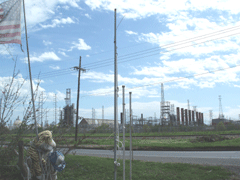
The Chalmette refinery and adjoining facilities.
(Photo: Ingrid Lobet)
LACOUR: I believe you’re right, I don’t think any penalties have been issued since then.
LOBET: ExxonMobil declined numerous requests for an interview but via email said the company is investing 200 million dollars in environmental improvements at Chamette. In the view of the Refinery Reform Campaign, an activist group, this situation isn't unique to Chalmette. Denny Larson is national coordinator.
LARSON: The levels of enforcement and oversight and monitoring and the state and local agencies, has almost gone to nil. I would argue, for fear that they would be caught in the claim that they're causing high gas prices, they're causing a shortage of gasoline supply. And the people who are coming back to try rebuild their lives in the shadow of refineries are suffering doubly because of that.
LOBET: There is another major trend Chalmette witnesses from its front row, Gulf Coast seats. From just across the waters to the south, come tankers filled with heavier, dirtier crude from Venezuela. Chalmette refinery uses the heavy crude, and so do more and more others. When it comes to oil, not all is created equal. You’ve heard of light, sweet crude? The “sweet” means less sulfur. Sour crude contains more sulfur, and sulfur has to be removed. “Light” means oil that’s thinner, easier to refine. Analytical chemist, Alex Cuclis worked at a Shell refinery for 15 years and now manages research at the Houston Advanced Research Center.
CUCLIS: All the crude oil sources are getting heavier, which means there’s more asphalt-like material available.
LOBET: Heavier crudes often require extra machinery. Refiners are increasingly installing a special kind of machine called a coker to deal with the grainy remains of heavier crudes.
CUCLIS: Cokers can be as tall as 100 feet tall and 25 feet in diameter drums, that are used to process material that is the bottom of the barrel material in an oil refinery. They heat it up to 900 degrees Fahrenheit in a furnace and it will vaporize and some will go on out and be recovered as gasoline and other light products. The remainder will coke up and about 30% of it becomes a solid coke. These drums will fill up, anywhere from say 8 to 18 hours, and once they’re filled, they need to be opened up and the coke is dropped out the bottom.
LOBET: Ken Ford says often when the air in his neighborhood is sharp with some smell and he calls the refinery, he’s told they’re having problems with the coker.
FORD: The times I’ve called, most of the time it’s the coker #2, coker #2, coker #2.
LOBET: Again, activist Denny Larson with the Refinery Reform Campaign.
LARSON: When you bring in a dirty sour crude, that means more pollution for the neighborhoods, it also means not just routine pollution because you got to pull that sour gas and things out, but you tend to get more upsets, malfunctions, flare offs, fires and explosions. So it's not only dirty to the enviornment, it's dangerous to the neighbors.
LOBET: But refiners don't agree. Cindy Schild of the American Petroleum Institute says while it's true refiners are taking in more sour and heavy crude, that doesn't necessarily translate to more emissions.
SCHILD: Every unit that is added at a refinery is going to have to meet environmental permitting requirements so that would be any federal, state or local standard. If you’re talking about adding more volume at refineries, it’s possible that the amount of emissions could increase somewhere. Lust like anything else, if you’re making more of something. But you got to keep in mind that nothing is going to go through that is going to violate any clean air standards or other environmental regulations.
LOBET: Indeed, this region of Louisiana meets all federal air quality standards. But these guidelines say nothing about individual neighborhoods or hotspots. And several experts told Living on Earth something surprising. They say new data shows these proliferating cokers are giving off huge amounts of pollutants—amounts that could actually equal or surpass the emissions of the entire refinery for VOCs, or volatile organic compounds. Again Alex Cuclis:
CUCLIS: That’s really what is a big controversy going on right now in EPA, and elsewhere. In this recent report in Canada, they found that the emissions from these coke drums were substantial. In fact, two and a half times what the refinery had reported for the entire refinery that year. For VOCs. And they also found benzene levels that were the highest source of benzene, aside from storage tanks, in the refinery as well.
LOBET: That bears reiteration. VOCs have a strong role in air pollution, and many are carcinogenic or harmful to the liver and kidneys. Regulators haven’t known that cokers release any VOCs, and now it turns out they may release as much or more as the entire facilities of which they’re a part.
But that’s not all. For years Chalmette and other U.S. refineries have estimated their total emissions. But data from Europe and Canada, shows refineries are very likely giving off much higher emissions than previously thought.
CUCLIS: There have been over 30 studies done at different refineries and in the best case, the refineries are at least three times higher than they are reporting, more typically they’re 10 times higher, and sometimes 30 times higher or more than what they report.
LOBET: In fact privately, government officials say they’ve been looking in the wrong places for pollutants. This massive undercounting of emissions has skewed regulatory efforts. What’s making these extraordinary figures come to light is technology.
Using infrared and ultraviolet techniques, some first developed for the military, you can now point a beam of light at say, a boat’s smokestack, a pipe, or a tank full of volatile liquid, and an invisible plume becomes visible.
GAMILES: See right now do you not smell something?
LOBET: I’m sitting in an SUV outside a refinery in Los Angeles with Don Gamiles. Gamiles began his career in physics and nuclear engineering at Oak Ridge National Lab. His interest in monitoring put him on the Iraq weapons inspection team before the second Iraq war. But what he’s riveted by are the possibilities offered by this monitoring technology.
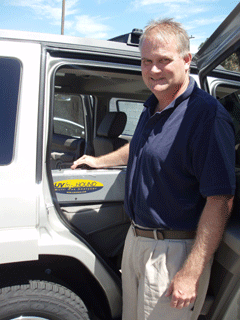
Don Gamiles with a real-time air monitor that he developed himself. (Photo: Ingrid Lobet)
GAMILES: See now we are getting toluene, so hydrocarbons are showing up along with toluene.
LOBET: He’s showing me a device he’s developed that you can put in the back seat of a vehicle. It continuously samples air through a hose stuck out the window. The air is fed into a box where it passes through a beam of light.
GAMILES: Ultraviolet light very close to what you would with a tanning bed bulb and gases in there will absorb different wavelengths of light. And different gases will actually absorb different wavelengths. So each gas in essence creates its own fingerprint. And you can see there’s absorption peaks there, absorption peaks there, and absorption peaks right in the middle. The one in the middle that’s benzene, that’s the fingerprint for benzene, are these four peaks.
LOBET: With a laptop screen set on the dashboard, as we drive, the machine generates a constantly-updating, real-time readout for 9 gases he’s chosen—today it’s benzene, butadiene, xylene, toluene, unburned gasoline, ammonia, sulfur dioxide, nitric oxide and ozone. It cannot measure particles.
GAMILES: The beauty of all of this stuff is that as we have been sitting here and this has been taking air into the system, how much has it cost us? Nothing.
LOBET: Nothing beyond the purchase cost of 25 thousand dollars for this, or 65 thousands for some of the infrared systems. But with traditional canister sampling, if you gathered one single sample a day for a year, and sent it off to a lab for analysis, you could easily spend 150 thousand dollars and have much less of a picture.
Refinery chemists, state regulators and environmentalists are increasingly using these types of technology to find hotspots that have long gone undetected. Gamiles says some refiners are using it to prove that not all the complaints they receive are really their fault. He cites one he’s been working with.
GAMILES: They were able to that show 40% of the problem was not them.
LOBET: Industry was skeptical of the technology at first, arguing it was unreliable. But Howard Feldman of the American Petroleum Institute says current systems measure up.
FELDMAN: In general we support having the most accurate emissions numbers, and we do believe these technologies work. And if that’s where it leads to and if there are facilities that need to be tightened, I think that the consensus of the industry is that people should operate within their permitted limits.
LOBET: Environmental advocates in Chalmette and elsewhere desperately want refineries to use the new continuous monitors and mobile cameras. Gamiles says they’re driving the adoption of this technology.
GAMILES: They were interested and they saw the need. They are the ones, more than the EPA, who have pushed this type of technology and is bringing it to the forefront in the U.S. Without them, there would be no market whatsoever.
LOBET: And it’s no mystery why. Real time data on specific gases crossing the refinery fence line, potentially shifts power into the hands of the community. One ConocoPhilips refinery in northern California has taken this step. So far, Chalmette has declined. Resident Ken Ford says he hopes he lives long enough to see accurate measurement of the air people are breathing.
FORD: I’m not a religious fanatic, and I don’t mean to sound like one, but sometimes I really believe, you know everybody has a purpose, and sometimes I think I got a purpose fighting this stuff. But my body is wearing out, I’m getting old. If somebody would have done what I’m doing as hard as I’m doing, with me 20 years ago, I may have my left lung right now.
For Living On Earth, I’m Ingrid Lobet.
[MUSIC: Branford Marsalis Quartet “Autumn Lamp” Romare Bearden Revealed (Marsalis Music - 2003)]
Related links:
- Louisiana Bucket Brigade
- Refinery Reform Campaign
- Exxon Mobile Chalmette Site
- Houston Advanced Research Center
CURWOOD: Coming up: why you might want to be careful about that plastic baby bottle.
That’s just ahead on Living on Earth.
ANNOUNCER: Support for the environmental health desk at Living on Earth comes from
the Cedar Tree Foundation. Support also comes from the Richard and Rhoda Goldman Fund for coverage of population and the environment. This is Living on Earth on PRI, Public Radio International.
Bisphenol A on the Burner

Dr. Ana Soto. (Courtesy of Dr. Ana Soto)
CURWOOD: It’s Living on Earth. I’m Steve Curwood. The debate over the safety of Bisphenol A continues to heat up with a number of new studies being published and the establishment of a government panel to review the data.
Invented more than a 100 years ago, Bisphenol A makes a strong and resilient plastic that is used in everything from the lining of tin cans to keep food fresh to polycarbonate baby bottles, anti-cavity tooth sealants, contact lenses, and even the jug in your office water cooler. The chemical mimics the hormone estrogen, and there’s a growing body of scientific knowledge that’s raising concerns about Bisphenol A’s impact on health, from suspected links to breast and prostate cancers to obesity. Living on Earth’s Ashley Ahearn has the latest developments.
[WATER BUBBLER GURGLING]
AHEARN: You don’t have to go far to find Bisphenol A. I’m in the kitchen at Living on Earth right now, standing in front of the water cooler, staring down this large five-gallon jug of water on top. And I’m giving it the evil eye because I know that there is Bisphenol A leaching from this jug into the water that I’m drinking every day. What I don’t know is how concerned I should be about that. I mean, Bisphenol A seems to be everywhere.
SOTO: It’s for certain that some of it will be there.
AHEARN: That’s Dr. Ana Soto. She’s a professor in the department of anatomy and cell biology at Tufts University, and has been studying estrogen imitators, like Bisphenol A, since they were first accidentally discovered to be leaching from plastics in the lab, into lab animals back in 1989.

Dr. Ana Soto. (Courtesy of Dr. Ana Soto)
AHEARN: Bisphenol A, or BPA is a chemical compound that mimics estrogen and when it gets in our body, it sends mixed messages to our endocrine system, especially if we’re exposed to it in the womb or as small children.
When lab mice and rats are exposed to BPA at levels similar to those currently found in humans, they show altered behavior and menstrual cycles and an increase in prostate cancer, breast cancer and type II diabetes. Dr. Soto says it’s time to start looking in the mirror because these are people problems too.
SOTO: So for example we know that there is an increase in prostate and breast cancer incidence, early onset of puberty in girls, metabolic disorders like insulin resistance, type II diabetes and obesity, and neurobehavioral problems. So you see, there is a parallel.
AHEARN: New research also draws a parallel between Bisphenol A and Diethylsylbestrol, or DES, a drug that was prescribed to pregnant women from the 40’s to the 70’s to prevent miscarriages with famously sad consequences.
NEWBOLD: It was later shown to be associated with cancer in the daughters of the women who took it while they were pregnant.
AHEARN: That’s Retha Newbold, a developmental reproductive biologist for the National Institute of Environmental Health Sciences. She conducted the research on DES and Bisphenol A.
Scientists and policy makers are sometimes hesitant about applying results found in lab animals to people. But Retha Newbold says the documented human health impacts of DES offer a precautionary tale that should be applied to Bisphenol A.
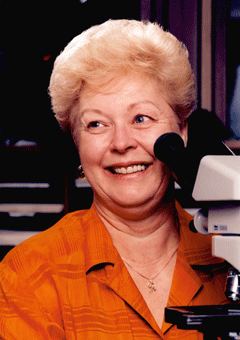
Retha Newbold (Courtesy of NIEHS)
AHEARN: Newbold’s research found some surprising parallel health impacts to mice exposed to DES and mice exposed to Bisphenol A.
NEWBOLD: If we expose animals to DES during development we get a pretty high instance of cystic ovaries and we get that same high incidence with Bisphenol A. We also see an increased incidence in a tumor that would be called uterine fibroids.
AHEARN: Retha Newbold, Dr. Ana Soto and 36 other scientific experts on Bisphenol A and reproductive health, have just signed a consensus statement saying that amount of BPA routinely found in the blood of Americans is higher than levels that produce a wide range of negative health effects in animals.
Right now the exposure limit set by the EPA for Bisphenol A is two thousand
times greater than the relative levels where Dr. Soto sees effects on her lab animals. She says more needs to be done to eliminate Bisphenol A from products used by the general public.
SOTO: At this moment, I think that the government has to start regulating to lower the exposure of pregnant women and children.
AHEARN: But not all scientists are convinced that BPA is a serious health risk. Robert Chapin is the chair of the panel convening next week, under the National Toxicology Program, to draft a document that will advise the government on the risks of BPA. He’s also a research advisor for the Pfizer pharmaceutical company.
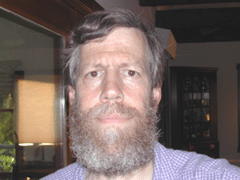
Robert Chapin (Courtesy of Robert Chapin)
AHEARN: As the scientific debate reaches the boiling point, some political leaders are beginning to take action. Proposed legislation banning Bisphenol A in children’s products in California, Maryland, and Minnesota was defeated. But, Japan did ban Bisphenol A in canned food and found that levels of the chemical fell in human beings by 50%.
San Francisco banned infant and children’s products containing Bisphenol A last summer, but the ban was repealed after chemical and toy companies filed lawsuits.
When it comes to the choices we make at home, environmental health advocates recommend people avoid canned food and hard, clear plastic bottles and other plastic containers, especially if they’re starting to show signs of wear because BPA leeches more as plastic ages.
For Living on Earth, I’m Ashley Ahearn.
[MUSIC: Morphine “I Had My Chance” “Get Shorty Soundtrack” (PolyGram Records, Inc. – 1995]
Related links:
- National Toxicology Program Panel
- Information on Bisphenol A
- The consensus statement of 38 scientific experts outlining concerns about Bisphenol A.
- Retha Newbold’s research comparing DES and BPA
- Study on human exposure levels to Bisphenol A
CURWOOD: Coming up: best friends forever with a buffalo. But first this Note on Emerging Science from Amy Fish.
Emerging Science Note/Super Sponge
[BARNEY CLEAN UP SONG]
FISH: For one group of scientists at Argonne National Laboratory, it’s clean up time.
[SCIENCE NOTE THEME]
FISH: The Argonne researchers unexpectedly discovered the formula for a new, highly absorbent material that acts like a super sponge. The new substance is a type of aerogel, a strong, lightweight material that feels like Styrofoam.
Microscopic pores in the aerogel create an enormous surface area. A single cubic centimeter—less than a thimbleful—of the Argonne gel could cover an entire football field. It’s this huge surface area that makes the super porous gel such a powerful sponge.
The new material is also versatile. By adjusting the ingredients and the size of the pores, scientists can fine-tune the aerogel to soak up specific chemicals. In one experiment, the gel absorbed 99.99 percent of toxic mercury in a container of contaminated water.
And one day, another version could remove one of the biggest obstacles to developing hydrogen fuel cells. Hydrogen gas contains impurities, such as carbon monoxide, which damage some fuel cells. Researchers believe an altered form of the gel could filter out the impurities and make fuel cells far more efficient.
With the help of the new Argonne aerogel, we could be cleaning our way to a greener future.
That’s this week’s Note on Emerging Science. I’m Amy Fish.
A Buffalo in the House
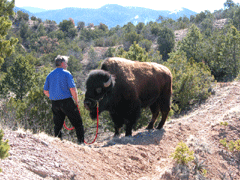
Roger takes Charlie out on the trail for a little exercise. (Courtesy of R.D. Rosen.)
CURWOOD: Over a century ago, the Texas ranch of Charles and Mary Ann Goodnight played a critical role in saving the southern bison herd from extinction. Mrs. Goodnight convinced her husband to take in some baby buffalo that had been orphaned, and raise them on the ranch. Their story inspired artist and distant relative Veryl Goodnight. She wanted to make a sculpture depicting a rancher's wife bottle-feeding a baby buffalo, just like Mary Ann Goodnight once did. The hitch was, she needed a live model. Veryl Goodnight and her husband, Roger Brooks, found their model in a less than a week old abandoned buffalo calf named Charlie. But Charlie, as it turns out, would become a much bigger part of their lives. The story is chronicled in a new book by R.D. Rosen called "A Buffalo in the House." With me now are Veryl Goodnight and Roger Brooks. Hello, there.
GOODNIGHT: Hi there.
BROOKS: Hello Steve.
CURWOOD: Or maybe I should say howdy.
GOODNIGHT: Howdy, we are out West.
CURWOOD: The sculpture is of a baby bison. So it doesn’t take very long for him to well, you know, not be needed any longer as your model right Veryl?
GOODNIGHT: My idea was to borrow this baby buffalo to use him for a model and then return him up to the ranch. I sculpted him when he was about a month old so it went fairly quickly. I was done with him in about a month, six weeks, somewhere around there but in the mean time Roger and Charlie had fallen in love with each other. So, the idea of returning him met with some resistance.
CURWOOD: I’m assuming at the time you got the baby buffalo that maybe he weighs 100 pounds or something. But this is a critter that’s going to weigh what 2200 pounds, a ton.
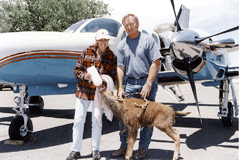
Roger and Veryl pick up Charlie in Idaho. (Courtesy of R.D. Rosen)
CURWOOD: Paralyzed.
BROOKS: Yeah.
GOODNIGHT: Quadriplegic and they thought that Charlie’s legs could possibly come back. So, he stayed at the hospital for a month and sure enough he was able to get up again on his own but he could never be pasture sound. He could never be out with other buffalo.
CURWOOD: So you now have yourself a 400 no maybe 500, on its way to 2200 pound pet.
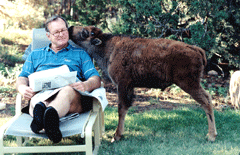
A nosey bison teen! (Courtesy of R.D. Rosen)
BROOKS: That’s right. We had never intended to make a pet out of him. But we not only had one but one that could really barely walk and took a lot of rehabilitative care.
CURWOOD: So, what’s it like to live with a buffalo?
BROOKS: Oh, gee I could look out my office window and see him out there and it just you know was always very heartening. To be able to lay down beside a big beast like this and to relate on a level, a common level that we found was an experience in my mind that could not be matched.
CURWOOD: Roger, you can go ahead and tell me. You’d cuddle up with Charlie like a big buffalo blanket?
BROOKS: (laughs) Well, I would lay down beside him at times, absolutely and I could scratch him and, gee when I’d scratch his belly he’d even lift a leg so that I could get a better scratch on him. One thing that to me is interesting is that I could touch any part of his body accept for his horns. His horns were sacred and I needed permission to touch them.
CURWOOD: Roger, how do you get permission from a buffalo to touch his or her horns?
BROOKS: (laughs) Well, you definitely need their trust and you have to ask and a lot of times you have to ask repeatedly. Charlie’s first answer to any question was no. And then you started a negotiating process. When we were out hiking Charlie would sometimes stop and basically tell me, “well, I’m not going to leave here forever.” And” Charlie, well gee why don’t we go just a little bit forward?” “No.” “Well, Charlie, ok the we’ll stay here.” You just let a little bit of time pass and then negotiate with him and most of the time I could get my way but it took a lot of patience.

Roger takes Charlie out on the trail for a little exercise. (Courtesy of R.D. Rosen.)
CURWOOD: I’m thinking of those bison horns and um, you read stories about other people that have had bison pets or tried to keep them at least around the corral and there’s more than one story where they wind up getting impaled on those.
BROOKS: That was always there. I never went in with Charlie without realizing I was going in with a wild animal. One thing, Steve, that I feel to describe the balance that I had to have with Charlie is that I could not let him dominate me. If he dominated me, he would hurt me. It would just be very natural with him. But I could not dominate him more than the slightest amount because if I dominated him unfairly he would resent me and he would hurt me.
CURWOOD: Veryl, what was it like watching Roger and Charlie’s relationship grow?
GOODNIGHT: The intensity of the relationship between the two of them was beyond anything that I and most animal lovers have ever experienced. I think part of it is Roger. I mean he’s big, athletic man’s man combined with this big powerful bull bison. I mean it’s a relationship that I could never duplicate. It was very exciting, not that at times I wasn’t jealous of it. I’m going to have to admit to that. (laughs) But I think I was more jealous of the relationship than I was jealous of Charlie. I love Charlie too, very, very much.
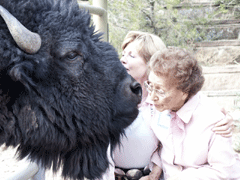
Meet n’ Greet. (Courtesy of R.D. Rosen)
GOODNIGHT: Well, we lost him at the age of three, Steve. I think I better tell this because Roger still gets choked up. Charlie continued to have a week neck. When he was three he got his head stuck under the lowest rail in the arena. Roger was home alone and had to get him up with the aid of the fire department. But he got him up but Charlie was back down again in a couple of days. And if they’re down on their side for long they get fluid in their lungs. And Charlie did and he contracted pneumonia and we lost him.
CURWOOD: There’s a saying that life is what happens along the way to the plans that we have and usually what happens is way different. What’s the best thing that happened to you as a consequence of having Charlie come into your life?
GOODNIGHT: Charlie was a gift. I think Richard Rosen sums it up beautifully in his book if I could just read one sentence here. He said, “It was as if this gentle wounded buffalo had been sent out among people so that they could touch and smell a world that had been left behind, so that they might enter gracefully into nature.”
CURWOOD: Roger?
BROOKS: I don’t know Steve, how I can answer that. I was so honored to share part of my life with this big bull bison. And his loss to me was more sorrowful to me than even the loss of my parents. So, you know it’s one of life’s unique opportunities. People have those in various forms and living Charlie was mine.
CURWOOD: Well, I want to thank you for taking this time with me. Veryl Goodnight and Roger Brooks are the subjects of the book, “Buffalo in the House” by R. D. Rosen. Thank you both.
GOODNIGHT: Thank you.
BROOKS: You’re welcome, Steve. Thank you.
[MUSIC: The Californians “Home on the Range” ‘Western Songs and Trail Ballads’ (Digital Musicworks International, Inc. – 2006)]
CURWOOD: Veryl Goodnight and Roger Brooks moved from Sante Fe, New Mexico to southwestern Colorado, where there is a buffalo herd nearby. Roger Brooks is now active in efforts to protect the bison of Yellowstone.
Related link:
A Buffalo in the House website
CURWOOD: On the next Living on Earth: cars are killing huge numbers of barn owls all over the world, and Interstate 84 in southern Idaho is no exception.
BOVES: We've found three or four times more dead barn owls than squirrels than skunks than raccoons than cats than dogs. They are the most commonly killed animal along the highway.
CURWOOD: Researchers try to find a reason and a solution. It’s the barn owl road kill mystery next time on Living on Earth.
[BUBBLE SOUND]
CURWOOD: We leave you this week, with a bit of bubble, bubble, toil and trouble.
|
|
[MUSIC: “ Larger Paint Pot “ recorded by John R. Beham for ‘Yellowstone National Park – An Audio Tour of Discovery’ (Benham Audiophile Recordings – 2004)]
CURWOOD: The mudpots of Yellowstone National Park are acidic springs of hot, muddy water that form in geothermal areas. Various gases from deep within the earth, escape through the wet clay mud, causing it to bubble. The gurgles of this multi-colored Artist Paint Pot were recorded by John R. Benham.
Living on Earth is produced by the World Media Foundation. Our crew includes Ashley Ahearn, Eileen Bolinsky, Bruce Gellerman, Ian Gray, Ingrid Lobet, Andrea Smardon, and Jeff Young - with help from Bobby Bascomb, Jeff Turton and Kelley Cronin. Our interns are Lauren Cox and Amy Fish. Aaron Read engineered our show this week.
Alison Lirish Dean composed our themes. I’m Steve Curwood. You can find us at LOE dot org.
Thanks for listening.
ANNOUNCER: Funding for Living on Earth comes from the National Science Foundation, supporting coverage of emerging science. And, Stonyfield Farm; organic yogurt and smoothies. Stonyfield pays its farmers not to use artificial hormones on their cows. Details at stonyfield.com. Support also comes from you, our listeners, the Ford Foundation, the Geraldine R. Dodge Foundation and the Saunders Hotel Group of Boston’s Lennox and Copley Square hotels. Serving you and the environment while helping preserve the past and protect the future. 1-800-225-7676. And Pax World Mutual Funds; socially and environmentally sustainable investing. Pax World, for tomorrow. On the Web at paxworld dot com.
Living on Earth wants to hear from you!
Living on Earth
62 Calef Highway, Suite 212
Lee, NH 03861
Telephone: 617-287-4121
E-mail: comments@loe.org
Newsletter [Click here]
Donate to Living on Earth!
Living on Earth is an independent media program and relies entirely on contributions from listeners and institutions supporting public service. Please donate now to preserve an independent environmental voice.
NewsletterLiving on Earth offers a weekly delivery of the show's rundown to your mailbox. Sign up for our newsletter today!
 Sailors For The Sea: Be the change you want to sea.
Sailors For The Sea: Be the change you want to sea.
 Creating positive outcomes for future generations.
Creating positive outcomes for future generations.
 Innovating to make the world a better, more sustainable place to live. Listen to the race to 9 billion
Innovating to make the world a better, more sustainable place to live. Listen to the race to 9 billion
 The Grantham Foundation for the Protection of the Environment: Committed to protecting and improving the health of the global environment.
The Grantham Foundation for the Protection of the Environment: Committed to protecting and improving the health of the global environment.
 Contribute to Living on Earth and receive, as our gift to you, an archival print of one of Mark Seth Lender's extraordinary wildlife photographs. Follow the link to see Mark's current collection of photographs.
Contribute to Living on Earth and receive, as our gift to you, an archival print of one of Mark Seth Lender's extraordinary wildlife photographs. Follow the link to see Mark's current collection of photographs.
 Buy a signed copy of Mark Seth Lender's book Smeagull the Seagull & support Living on Earth
Buy a signed copy of Mark Seth Lender's book Smeagull the Seagull & support Living on Earth


